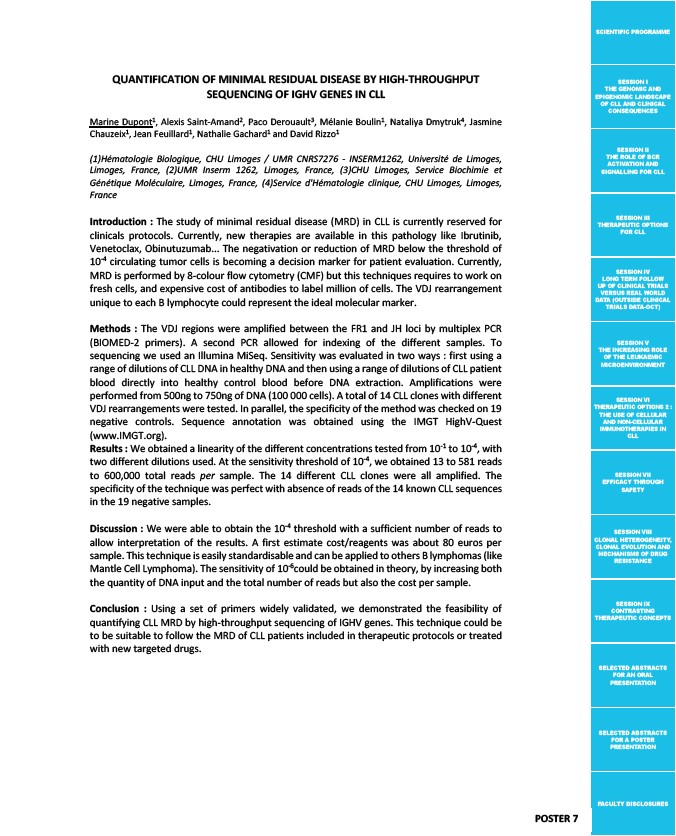
SCIENTIFIC PROGRAMME
SESSION I
THE GENOMIC AND
EPIGENOMIC LANDSCAPE
OF CLL AND CLINICAL
CONSEQUENCES
SESSION II
THE ROLE OF BCR
ACTIVATION AND
SIGNALLING FOR CLL
SESSION III
THERAPEUTIC OPTIONS
FOR CLL
SESSION IV
LONG TERM FOLLOW
UP OF CLINICAL TRIALS
VERSUS REAL WORLD
DATA (OUTSIDE CLINICAL
TRIALS DATA-OCT)
SESSION V
THE INCREASING ROLE
OF THE LEUKAEMIC
MICROENVIRONMENT
SESSION VI
THERAPEUTIC OPTIONS 2 :
THE USE OF CELLULAR
AND NON-CELLULAR
IMMUNOTHERAPIES IN
CLL
SESSION VII
EFFICACY THROUGH
SAFETY
SESSION VIII
CLONAL HETEROGENEITY,
CLONAL EVOLUTION AND
MECHANISMS OF DRUG
RESISTANCE
SESSION IX
CONTRASTING
THERAPEUTIC CONCEPTS
SELECTED ABSTRACTS
FOR AN ORAL
PRESENTATION
SELECTED ABSTRACTS
FOR A POSTER
PRESENTATION
FACULTY DISCLOSURES
QUANTIFICATION OF MINIMAL RESIDUAL DISEASE BY HIGH-THROUGHPUT
SEQUENCING OF IGHV GENES IN CLL
Marine Dupont1, Alexis Saint-Amand2, Paco Derouault3, Mélanie Boulin1, Nataliya Dmytruk4, Jasmine
Chauzeix1, Jean Feuillard1, Nathalie Gachard1 and David Rizzo1
(1)Hématologie Biologique, CHU Limoges / UMR CNRS7276 - INSERM1262, Université de Limoges,
Limoges, France, (2)UMR Inserm 1262, Limoges, France, (3)CHU Limoges, Service Biochimie et
Génétique Moléculaire, Limoges, France, (4)Service d'Hématologie clinique, CHU Limoges, Limoges,
France
Introduction : The study of minimal residual disease (MRD) in CLL is currently reserved for
clinicals protocols. Currently, new therapies are available in this pathology like Ibrutinib,
Venetoclax, Obinutuzumab... The negativation or reduction of MRD below the threshold of
10-4 circulating tumor cells is becoming a decision marker for patient evaluation. Currently,
MRD is performed by 8-colour flow cytometry (CMF) but this techniques requires to work on
fresh cells, and expensive cost of antibodies to label million of cells. The VDJ rearrangement
unique to each B lymphocyte could represent the ideal molecular marker.
Methods : The VDJ regions were amplified between the FR1 and JH loci by multiplex PCR
(BIOMED-2 primers). A second PCR allowed for indexing of the different samples. To
sequencing we used an Illumina MiSeq. Sensitivity was evaluated in two ways : first using a
range of dilutions of CLL DNA in healthy DNA and then using a range of dilutions of CLL patient
blood directly into healthy control blood before DNA extraction. Amplifications were
performed from 500ng to 750ng of DNA (100 000 cells). A total of 14 CLL clones with different
VDJ rearrangements were tested. In parallel, the specificity of the method was checked on 19
negative controls. Sequence annotation was obtained using the IMGT HighV-Quest
(www.IMGT.org).
Results : We obtained a linearity of the different concentrations tested from 10-1 to 10-4, with
two different dilutions used. At the sensitivity threshold of 10-4, we obtained 13 to 581 reads
to 600,000 total reads per sample. The 14 different CLL clones were all amplified. The
specificity of the technique was perfect with absence of reads of the 14 known CLL sequences
in the 19 negative samples.
Discussion : We were able to obtain the 10-4 threshold with a sufficient number of reads to
allow interpretation of the results. A first estimate cost/reagents was about 80 euros per
sample. This technique is easily standardisable and can be applied to others B lymphomas (like
Mantle Cell Lymphoma). The sensitivity of 10-6could be obtained in theory, by increasing both
the quantity of DNA input and the total number of reads but also the cost per sample.
Conclusion : Using a set of primers widely validated, we demonstrated the feasibility of
quantifying CLL MRD by high-throughput sequencing of IGHV genes. This technique could be
to be suitable to follow the MRD of CLL patients included in therapeutic protocols or treated
with new targeted drugs.
POSTER 7